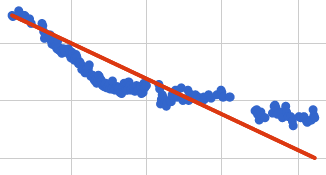Quantitatively, though, I get a C-minus. I only made it 72% of the way toward my goal. I’m 9.6% lighter than I was one year ago; I was aiming for 13.4%. (On the other hand, if you measure from my heaviest point, which was less than one year ago, to my lightest point, which was a few days ago, I lost 10.8% of my body weight.)

As you can see from the graph, after an exciting fast start, losing weight was a stop-and-go proposition.
At Google, teams are encouraged to set measurable goals at the beginning of each quarter, and then to measure them at the end of each quarter. Scores of 100% are great, of course, but we’re taught that the ideal average score is actually around 70%. More than that and your goals aren’t ambitious enough. So maybe I should feel satisfied with my 72% (but I don’t).
My bathroom scale also measures body composition. According to that scale, my body-fat percentage went from “very high” to merely “high,” and my visceral fat number went from “high” to “normal.” My muscle-to-fat ratio climbed from 1.02 to 1.38. Gratifyingly, my “body age,” according to the scale, dropped from 56 to my actual age: 47.
My goal for the coming year is to lose another 10.2% of my weight. If I’m successful, my body-fat percentage will drop from “high” to “normal.” I’d also like to see my scale claim that my “body age” is lower than my actual age. Wish me luck…